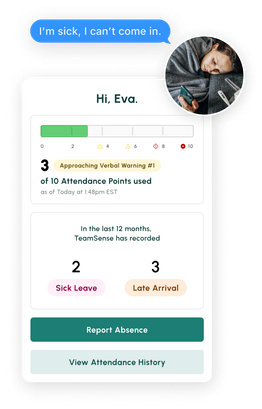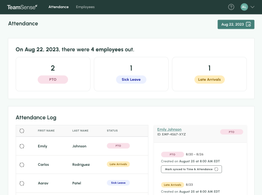Fix the root cause of No-Call No-Show with help from TeamSense
Table of Contents
It is no secret that technology has changed plenty of industries over the years, especially with the introduction of workplace apps and bring-your-own-device (BYOD) policies
Many hourly businesses have opted for using apps as a way to stay in touch with their employees, create a digital connection, and provide them more visibility into employee behavior and attendance.
In industries like restaurants or retail, apps are often welcomed because the workforce is mostly younger workers who are used to downloading apps for productivity.
On the other hand, industries like manufacturing and logistics have a more seasoned workforce, on average, and they have a harder time convincing their employees to download an app. Some may not know how to do it, and others feel suspicious that they might lose privacy if their company is in their phone.
So the big questions here are: Should you require your employees to download an app? And is an app really the most productive way to connect with your team?
What Are Employee Apps Used For?
Employee apps enable employees to receive work-related information, wherever they may be, through their smartphones. Employers might want to use an employee app for:
- Internal communication
- Team member collaboration
- Employee engagement
- Workflow tracking
- Scheduling shifts
- Attendance point systems
- Monitoring excessive absenteeism
- Attendance management and timekeeping
Benefits of an Employee App
Companies know that attracting and retaining employees is only getting tougher. Providing better support and communication with their employees is a good strategy for creating a more engaging environment, where people want to build a career. Technology can open those lines of communication, especially for hourly employees who may not have (or use) a company email address.
For example, since the pandemic, many companies have (rightfully so) started focusing more on employee well-being and mental health initiatives. Quick check-ins and pulse surveys are much easier and less pressured when done with the help of technology, especially with an audience with a stigma around mental health.
Employers also benefit from managing hourly workers’ time (or non-exempt workers) in multiple ways. Having hourly workers “punch in and punch out” on a smartphone app gives flexibility in tracking attendance and makes sure the correct hours are entered for payroll.
Advanced technology can make things much easier for a workforce that has always had a manual way of doing things, but what if your team isn’t as accepting of apps? Can employers make their employees download an app on their phones if they don’t want to?
The Future of Employee Management Is Here
(And it’s a lot simpler than you think). Get employee attendance, communication, engagement, and productivity all delivered over text.
Alternatives to Using Employee Mobile Apps
In our app-centered world, it can be difficult to imagine using a technology that doesn’t use an app. These days we can grocery shop, schedule appointments, and even have food magically delivered to our door all through the touch of an app.
But just because we’ve gotten used to app-based technology in our personal lives, that doesn’t mean everyone wants to use it or even has access to it for work. To track attendance, an employer might prefer alternatives to employee apps like these:
- Call-off hotline
- Pen and paper
- Voicemail
- Calling a manager directly
- Excel Spreadsheet
- Laptop, desktop, or kiosk time clocks
- Identity scanners (fingerprint, palm, or facial recognition)
- Text messages
That last one right there is our favorite. Using text-based technology to track attendance and communicate with your employees is simple, efficient, and takes the headache out of the whole thing.

7 Benefits of Using App-Free Text-Based Technology
It might be hard for you to wrap your mind around using app-free technology for attendance management. If it’s from a mobile device, doesn’t it need to be an app? But the truth is, texting is anything but archaic and old school. Here are five major benefits of using app-free technology like text for digital communication.
1. 100% Coverage
With a text-based attendance system, you can almost guarantee 100% coverage to all your employees across the company. Why? Because most people have phones that allow text messaging. The employees don’t have to have the latest and greatest smartphone to access it. And the employer doesn’t have to wait around and jump through all the compliance hoops either. Win-win.
Even better. Start with text-based use cases that employees will have to follow. For example, your call-off process. Most workers will call off at least once every few months, for illness, family commitments or vacation. If text-based call off is the easiest way, people will use it. And if a text comes in from a number that you don’t recognize, you’ve got a built-in opportunity to update your employees’ contact information. In an emergency, you’ll need a way to communicate with your entire workforce. By maintaining current contact info for hourly employees, you can bridge the communication gap and bring the organization closer together.
2. Never Having to Push Updates
Here’s a not-so-secret fact—people aren’t great about remembering to update their phone's apps or software. It’s a little too easy to press the “ignore” button for months on end.
Bonus: If your company doesn’t have an employee app, you don’t have to keep up with rolling out those updates to keep the technology up to date and secure. Using text-based technology means new updates and functionality can hit immediately—no need to ever update an app.
3. High Response Rates
Did you know that SMS text messages have a really high read and response rate? It's crazy but true, 99% of all text messages end up being looked at—with 90% of them being read in the first three minutes.1 Chances are you will get better interaction and engagement with your employees if you communicate with them through text, and not an app.
4. No Technology Gaps to Overcome
Hourly workers don’t jump on board new technology as willingly as others might. Since they’re already familiar with texting, there is less of a learning curve to deal with. Plus, most mobile devices come preloaded with browsers they have already learned to operate instead of learning how a new app functions.
5. Employees Prefer Text
Phone calls are awkward. Phone calls with one’s manager are more awkward. And phone calls to a supervisor when an employee is under the weather can be the worst. When it comes down to it, a lot of employees would rather communicate through text. In fact, 33% of American adults prefer text over any other type of communication—sorry, mobile apps.2 Employees who text off to a dedicated number avoid the hold time, inconvenience and discomfort of talking to their manager. If it’s quicker, easier and more comfortable to report an absence, more absences are reported and that rate of no call, no shows plummets.
6. Employees Don’t Need User Names or Passwords
No one wants yet another log-in and password to remember. Making your team download an employee app just adds more log-in credentials that they have to remember. And if they don’t recall what they are, they might get locked out and can’t report an absence or communicate with you at all. And why give your employees a reason to avoid interaction with the company?
7. No More Language Barriers
Many employee apps are only in two to three different languages. And even if they support outbound communication in their desired language, the app might not let employees respond in their natural language. Having a text-based system that supports many languages and lets your employees communicate back to you will strengthen connection and engagement.
Can Employers Make Their Employees Download an App?
So, the question remains: Can you require your employees to download an app onto their personal smartphones?
The short answer is sure you can. But the real question is: Should you?
No one wants to feel like they’re living in an Orwellian novel. So, although it’s legal to require your employees to download an app, you might want to take a softer approach.
And to fully understand the impact of requiring your employees to download an app, you also need to think about whether the phone is the property of the company or the employee. If the phone belongs to the employee, you might not want to open up that can of worms.
After all, is an employee app really the best way to reach your team?


5 Cons of Using an App-Based Platform
An employee app might seem convenient at first, but there are a lot of drawbacks. Here are five cons that you should keep in mind, before of requiring employees to download a company app.
1. Privacy Concerns
Security is the main hang-up for employees when it comes to using an app. By downloading a work-related app onto their personal phones, many employees wonder if the employers now have access to the employee’s personal information? Will they know what I do and where I go after I leave work?
It might sound far-fetched, but it’s not. In 2019, Starbucks rolled out a new scheduling app called Teamworks. Starbucks workers could access their schedules through this app while clocking in and out of their shifts. However, despite its well-publicized rollout on a 2019 earnings call, issues immediately cropped up.3 Employees complained about the app on numerous internet forums when hours were incorrectly calculated and schedules showed up late.
One of their biggest worries? “Privacy concerns about downloading the app to their personal mobile devices because of the apps’ functionality and terms of service.” 4
The app required full access to personal devices, which made many employees uneasy. Other employees were skeptical, believing that data tracking would occur, despite promises from Starbucks not to let that happen.
In this tech-advanced world we live in, people are used to being cautious about their cyber security habits. Many hourly workers are aware that apps can be used to harvest personal data from their mobile devices—and they want no part of employee apps.
2. Employee Pushback
Here’s a no-so-surprising piece of information: Employees don’t want to download an app on their personal phones. Especially if they have to buy the app themselves or drain their personal data to use the app.
Suppose you ask employees to download an app onto a company-provided phone. In that case, it’s company property, and the employer can control how and when the phone is used—including downloading apps. But about requesting that an employee download an app to their personal phone? Prepare to get some pushback from the employee here.
To gain insight, ask your employees how they feel about downloading an app to their personal phones. Take a poll and get feedback from your teams before you decide to force something on them.
A lot of companies have seen low uptake when rolling out required apps to their employees. Forcing an app on an employee can lead to a wider trust gap between hourly workers and management. This is especially true in the manufacturing industry, where the workforce skews older and can also be unionized.
3. Union Agreements Can Prevent Apps
Speaking of unions, don’t forget to read the fine print on if they’d okay an employee app anyway. Some union agreements have strict policies that won’t let employers use an employee app. Be sure you know the policy before you try to roll anything out to your team.
4. Employers Could Pay Monthly Fees
If you’re requiring an employee to download an app on their personal phone, just be prepared that you could get roped into paying for part of the device or monthly bill for the employee. Look into what local regulations say about that. Multiply that by hundreds of employees, and things can get expensive fast.
5. You’ll Still Have Call-Outs and No-Shows
You could have the latest and greatest employee app with all the bells and whistles—but guess what? You’ll still have call-outs and no-shows happen. Just because you have swanky technology doesn’t mean your employees will use it. In fact, a lot of times—they don’t.
So, Should You Make Your Employees Download an App?
Nope. Make life easier for your employees and the company, and stick to text-based software.
TeamSense’s text-based employee software respects personal privacy but still brings all the functionality that employers would expect from an app. And there’s no friction here—hourly workers have no problem using TeamSense because they already know how to work the technology (they’ve been texting for years).
TeamSense lets employees text call-off to a dedicated number for your site, instead of downloading an app, calling a manager, navigating a phone tree, leaving a voicemail, or waiting on hold to talk with an operator. Because they avoid the hold time, inconvenience, or discomfort, more team members use the system. If they change numbers, no problem! When TeamSense gets a text from an unrecognized number, we ask the texter to confirm with their employee ID number, and then we can update their contact info on the back end. The result? A system your hourly employees love to use and a reliable digital connection that you can use to communicate with an individual, a team, or the whole company.

Save Hundreds of Hours A Year With TeamSense
See how TeamSense saved HelloFresh 3-4 hours per day managing attendance through text. Read the case study and book your demo today!
About the Author

Sheila Stafford, CEO of TeamSense & AI in HR Innovator
As CEO of TeamSense, Sheila Stafford is at the forefront of transforming HR for frontline teams through AI-driven solutions. With a commitment to enhancing employee relations and simplifying workforce management, Sheila leads TeamSense in pioneering advancements that empower both frontline employees and HR teams. Her visionary approach combines cutting-edge technology with a thoughtful focus on enhancing human connection; Sheila strategically implements AI where it adds the most value while recognizing the critical role of personal interaction and ensuring that human engagement remains central when it matters most. Under her leadership, TeamSense is redefining how companies support and engage their frontline teams for a more connected, efficient workplace.





